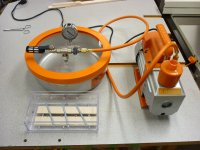Brent Dalrymple
PRO Member
I have a bowl designed that will use some colored segments. I couldn't find much information on the internet on dyeing wood (only veneer, but that's thin stuff) so I thought I'd do some experimenting. I bought a 1 gallon vacuum chamber and single-stage vacuum pump. In addition I bought an acrylic tray that is 2"x4"x8" and made a cover for it out of 1/16" acrylic (see photo). I also cut some pieces of 10-24 threaded rod to act as spacers and weights. I put a couple of hard maple strips, 3/16"x1"x7-1/4", into the tray using three spacers to hold them off of the bottom of the tray and 3 spacers as weights on top. I then added enough water-soluble aniline dye to cover the wood, put the top on the tray to keep splashing to a minimum, and put the tray in the chamber. This little chamber and pump will get to -29.5mm Hg in about a minute, but at that pressure water boils at room temperature, so I stopped pumping at 27mm Hg. Initially I could see a lot of bubbles caused by the air being evacuated from the wood. I let the strips sit under vacuum for about an hour, which may be longer than necessary, and then brought the chamber up to atmospheric pressure. I dried the wood strips and then cut them apart in several places to find that the dye had penetrated entirely through the wood strips. So, it looks like this is going to work--I can mill the maple strips, dye them, sand off the raised grain, and then cut my 1/8"-thick segments. In the photo below there are only two wood strips so you can see how the spacers are used, but the tray will easily hold 12 strips with spacers, so I can do about 7 ft. of 1/8"x1"x7" maple in one run.

